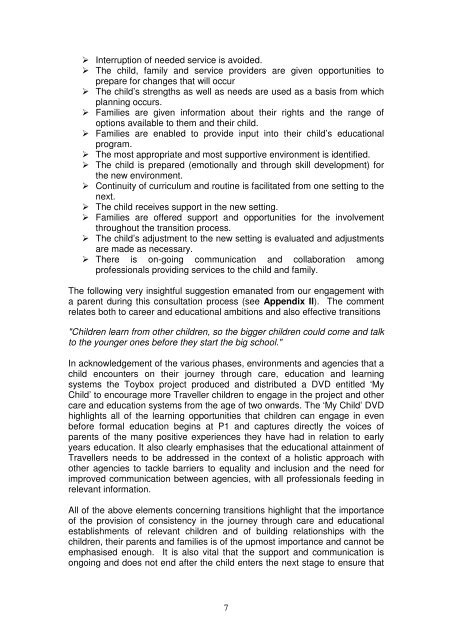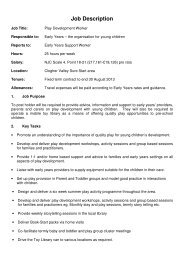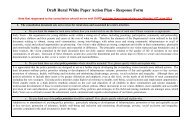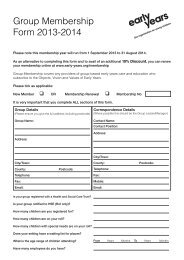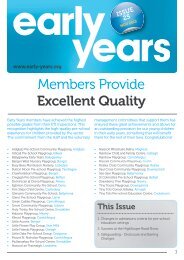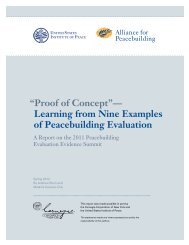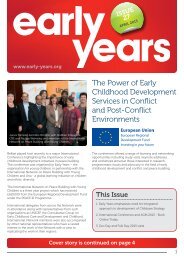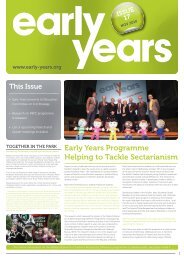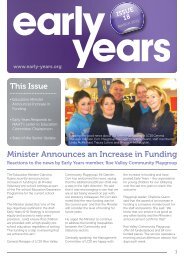Traveller Child in Education Action Framework - Early Years
Traveller Child in Education Action Framework - Early Years
Traveller Child in Education Action Framework - Early Years
Create successful ePaper yourself
Turn your PDF publications into a flip-book with our unique Google optimized e-Paper software.
Interruption of needed service is avoided. The child, family and service providers are given opportunities toprepare for changes that will occur The child’s strengths as well as needs are used as a basis from whichplann<strong>in</strong>g occurs. Families are given <strong>in</strong>formation about their rights and the range ofoptions available to them and their child. Families are enabled to provide <strong>in</strong>put <strong>in</strong>to their child’s educationalprogram. The most appropriate and most supportive environment is identified. The child is prepared (emotionally and through skill development) forthe new environment. Cont<strong>in</strong>uity of curriculum and rout<strong>in</strong>e is facilitated from one sett<strong>in</strong>g to thenext. The child receives support <strong>in</strong> the new sett<strong>in</strong>g. Families are offered support and opportunities for the <strong>in</strong>volvementthroughout the transition process. The child’s adjustment to the new sett<strong>in</strong>g is evaluated and adjustmentsare made as necessary. There is on-go<strong>in</strong>g communication and collaboration amongprofessionals provid<strong>in</strong>g services to the child and family.The follow<strong>in</strong>g very <strong>in</strong>sightful suggestion emanated from our engagement witha parent dur<strong>in</strong>g this consultation process (see Appendix II). The commentrelates both to career and educational ambitions and also effective transitions"<strong>Child</strong>ren learn from other children, so the bigger children could come and talkto the younger ones before they start the big school."In acknowledgement of the various phases, environments and agencies that achild encounters on their journey through care, education and learn<strong>in</strong>gsystems the Toybox project produced and distributed a DVD entitled ‘My<strong>Child</strong>’ to encourage more <strong>Traveller</strong> children to engage <strong>in</strong> the project and othercare and education systems from the age of two onwards. The ‘My <strong>Child</strong>’ DVDhighlights all of the learn<strong>in</strong>g opportunities that children can engage <strong>in</strong> evenbefore formal education beg<strong>in</strong>s at P1 and captures directly the voices ofparents of the many positive experiences they have had <strong>in</strong> relation to earlyyears education. It also clearly emphasises that the educational atta<strong>in</strong>ment of<strong>Traveller</strong>s needs to be addressed <strong>in</strong> the context of a holistic approach withother agencies to tackle barriers to equality and <strong>in</strong>clusion and the need forimproved communication between agencies, with all professionals feed<strong>in</strong>g <strong>in</strong>relevant <strong>in</strong>formation.All of the above elements concern<strong>in</strong>g transitions highlight that the importanceof the provision of consistency <strong>in</strong> the journey through care and educationalestablishments of relevant children and of build<strong>in</strong>g relationships with thechildren, their parents and families is of the upmost importance and cannot beemphasised enough. It is also vital that the support and communication isongo<strong>in</strong>g and does not end after the child enters the next stage to ensure that7


